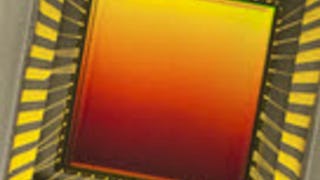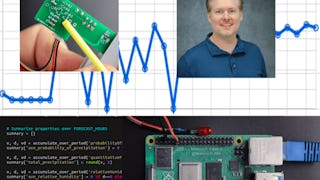Course two of this specialization is all about hardware physical layer and communication between elements of your project, how to troubleshoot high-speed signals when they don't work, and how to design your projects so they do work.

Profitez d'une croissance illimitée avec un an de Coursera Plus pour 199 $ (régulièrement 399 $). Économisez maintenant.

Communications and High-Speed Signals with Raspberry Pi
Ce cours fait partie de Spécialisation Raspberry Pi Projects

Instructeur : Drew Wilson
2 141 déjà inscrits
Inclus avec
(13 avis)
Compétences que vous acquerrez
- Catégorie : Communication Systems
- Catégorie : Electronic Systems
- Catégorie : Debugging
- Catégorie : Hardware Design
- Catégorie : Estimation
- Catégorie : Electronic Components
- Catégorie : Failure Analysis
- Catégorie : Network Analysis
- Catégorie : Electrical Engineering
- Catégorie : Digital Communications
- Catégorie : Simulation and Simulation Software
- Catégorie : Electronics
- Catégorie : Digital Signal Processing
Détails à connaître

Ajouter à votre profil LinkedIn
4 devoirs
Découvrez comment les employés des entreprises prestigieuses maîtrisent des compétences recherchées

Élaborez votre expertise du sujet
- Apprenez de nouveaux concepts auprès d'experts du secteur
- Acquérez une compréhension de base d'un sujet ou d'un outil
- Développez des compétences professionnelles avec des projets pratiques
- Obtenez un certificat professionnel partageable

Il y a 4 modules dans ce cours
In this first module, we will discuss a variety of modern communications protocols and point out features that we will refer back to in later discussions. These are digital signals, but if you think digital communications is all 1's and 0's, I'd like you to change your thinking and start thinking of every signal as an analog waveform. We'll discuss what that means and why it's important when building projects with high-performance communications links. We'll introduce some well-known protocols and also the emergning I3C protocol, the successor to I2C. Lastly, we'll take an in-depth look at a type of circuit called an open-drain driver. This is how an IC communicates on an I2C (and I3C) bus and is a great example circuit for studying all sorts of real-world effects on high-speed signals. We'll use this open-drain configuration as an example throughout the entire course. You may have seen some of this information before but it's worth briefly seeing again as this is the foundation that we'll be referring back to throughout the whole course. And it's worth building a strong foundation now, because Module 4 wraps up everything we've learned into five very useful rules of thumb that you can you in all of your future projects. One more thing. I know I speak slowly, so feel free to use the Coursera video player feature to play the videos at 1.5x or 2x speed.
Inclus
14 vidéos1 devoir
In Module two, we look into the physics of how high-speed signals are effected by real-world circuits and how that distortion effects our projects. We'll use math at times, but only to help develop an intuitive understanding. This is a critical part of developing the five Rules of Thumb in module 4. These valuable rules will help you troubleshoot and design circuits with high-speed signals in all sorts of future projects.
Inclus
11 vidéos1 devoir
Everything we've discussed has considered signals to be voltages that change in time. Picturing signals strictly in the time domain is only half the story, so get ready to shift your mind into the frequency domain. This module introduces frequency-domain concepts and how we can use the frequency domain to deeply understand how real-world circuit effects distort signals and can cause communications errors in our projects. At the end of this module is two extra videos on decibels and filter terminology. Feel free to skip them if you're very familiar with the topic, or feel free to watch them out of order if you need a little more background in those topics to understand the ideas here in module 3.
Inclus
12 vidéos1 devoir
After laying down a strong foundation in modules 1, 2, 3, we've finaly made it to module 4 and it's time to develop our five Rules of Thumb. These concepts were chosen for the rules of thumb in this module becuase they are extremely common trouble spots for new developers (and sometimes experienced developers, too). Each lesson builds on information in the earlier modules and distills a concept to an easy-to-remember rule that you can use on your future projects. Also included in teh resources is a handy one-page PDF summary of the five Rules of Thumb for you keep close by when you're working on your projects in the future.
Inclus
10 vidéos1 lecture1 devoir
Obtenez un certificat professionnel
Ajoutez ce titre à votre profil LinkedIn, à votre curriculum vitae ou à votre CV. Partagez-le sur les médias sociaux et dans votre évaluation des performances.
Instructeur

Offert par
En savoir plus sur Electrical Engineering
 Statut : Essai gratuit
Statut : Essai gratuitUniversity of California, Irvine
 Statut : Essai gratuit
Statut : Essai gratuitJohns Hopkins University
 Statut : Essai gratuit
Statut : Essai gratuitJohns Hopkins University
 Statut : Essai gratuit
Statut : Essai gratuitJohns Hopkins University
Pour quelles raisons les étudiants sur Coursera nous choisissent-ils pour leur carrière ?




Avis des étudiants
13 avis
- 5 stars
84,61 %
- 4 stars
15,38 %
- 3 stars
0 %
- 2 stars
0 %
- 1 star
0 %
Affichage de 3 sur 13
Révisé le 6 oct. 2024
Excellent introduction of theory and applications.
Foire Aux Questions
To access the course materials, assignments and to earn a Certificate, you will need to purchase the Certificate experience when you enroll in a course. You can try a Free Trial instead, or apply for Financial Aid. The course may offer 'Full Course, No Certificate' instead. This option lets you see all course materials, submit required assessments, and get a final grade. This also means that you will not be able to purchase a Certificate experience.
When you enroll in the course, you get access to all of the courses in the Specialization, and you earn a certificate when you complete the work. Your electronic Certificate will be added to your Accomplishments page - from there, you can print your Certificate or add it to your LinkedIn profile.
Yes. In select learning programs, you can apply for financial aid or a scholarship if you can’t afford the enrollment fee. If fin aid or scholarship is available for your learning program selection, you’ll find a link to apply on the description page.
Plus de questions
Aide financière disponible,





